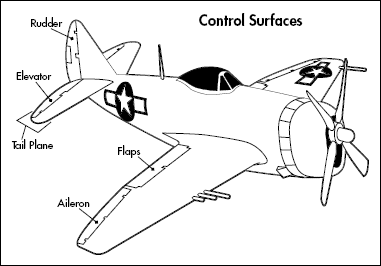
1. Physics | 2. Movement Vectors | 3. Control Surfaces | 4. Basic Flight Manouvers

3. CONTROL SURFACES
|
All control surfaces utilize the principle of lift, but they apply lift forces in different directions. ELEVATORS Elevators are flat, hinged surfaces on the tailplane (the horizontal part of the tail assembly). While the entire tailplane surface helps stabilize the aircraft during flight, the elevators apply pitch by angling the trailing (rear) edge of the tailplane up or down. To create pitch, gently pull the flight stick back or push it forward. Take care not to perform pitch maneuvers too quickly. If the angle of attack (angle that the air meets the wing) becomes too steep, the flow of air around the wings can become disrupted. Air no longer flows smoothly over the wing; instead, it buffets in several different directions and disrupts the air pressure around the wing's surface. This situation is called a stall.
RUDDERS The rudder is the vertical component of the tail assembly. The rear half of the vertical tail section is hinged, allowing it to angle left or right. When you apply rudder, you redirect the aircraft's nose either left or right. Applying left rudder yaws the nose to the left, while applying right rudder veers the nose to the right. Note that applying rudder also produces a very slight rolling movement, which can be negated by pushing the stick in the opposite direction. AILERONS Ailerons are thin, hinged surfaces on the outer, trailing edge of each wing. They angle in opposite directions to waggle the wings up and down or roll the aircraft about its nose-tail axis. If you apply stick left or right, one wing's aileron angles down and the other angles up. This rolls one wing up and forces the other wing down, effectively rolling the airplane. When you apply left stick, the left aileron raises and the right one drops, and the aircraft rolls to the left. The opposite occurs if you push the stick in the opposite direction. FLAPS Similar to ailerons, flaps are thin, hinged surfaces on the trailing edge of the wing. However, they are located nearer to the wing root than ailerons and operate in tandem. (If one flap is lowered or raised, so is the other.) A raised flap conforms to the wing's natural shape. A lowered flap alters the airflow around the wing, effectively changing the wing's aerodynamic shape and increasing the amount of available lift. You extend flaps during takeoff to gain additional lift, then retract them during flight to maximize your airspeed. While flaps increase your aircraft's angle of attack, they also increase drag. In a pinch, you can use flaps while chopping the throttle to quickly reduce your airspeed. One point to note is that flaps can only be extended at low to medium speeds. If the aircraft is traveling too fast, air flows too fast over the flaps, and they cause drag. In high-speed dives, flaps and other control surfaces may become unusable—air travels so fast over them that you can't move them until you slow down the aircraft. COMPRESSIBILITY Compressibility is a condition that renders an aircraft's control surfaces inoperable. It occurs at very high speeds, such as those attained during a long, steep dive. Air that flows around the airfoil surface separates into two directions at some point in front of each wing. This is called the point of impact. At higher speeds, this point moves further and further in front of the wing and creates pressure disturbances on and around the wing. As an aircraft's speed approaches Mach 1, the speed of the air flowing over the wings reaches the speed of sound before the aircraft does. Remember, air flows faster over the top of the wing and is actually traveling faster than the aircraft at any given point in time. Pressure waves generated by the movement of wings through the air act much like ripples on a pond. They radiate outward and “warn” the yet undisturbed air molecules in the path of the approaching wing. As the aircraft's speed approaches Mach 1, these pressure waves pile up in front of the wing. (The Mach number is the aircraft's speed divided by the speed of sound for the current altitude and temperature.) At some point, the wing is traveling so fast that the waves no longer radiate ahead of the wing. This creates shock waves and causes the aircraft to buffet. Aileron and elevator controls mounted on the wing and tail surfaces freeze up due to excessive pressure, or act in directions opposite than normal. The phenomenon of compressibility occurs only at very high speeds. The only remedy in WW II aircraft is to chop the throttle and attempt to pull out before it's too late. If you don't react quickly enough, your control surfaces may freeze and you could crash. |

1. Physics | 2. Movement Vectors | 3. Control Surfaces | 4. Basic Flight Manouvers
